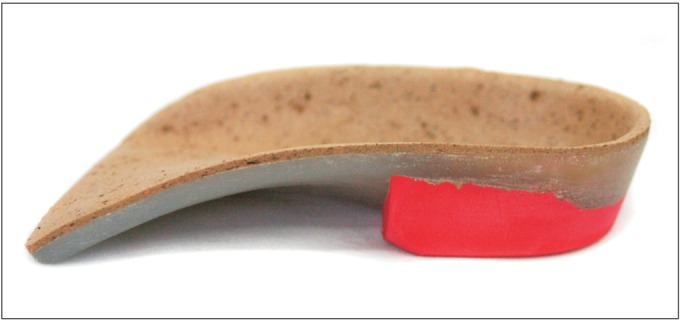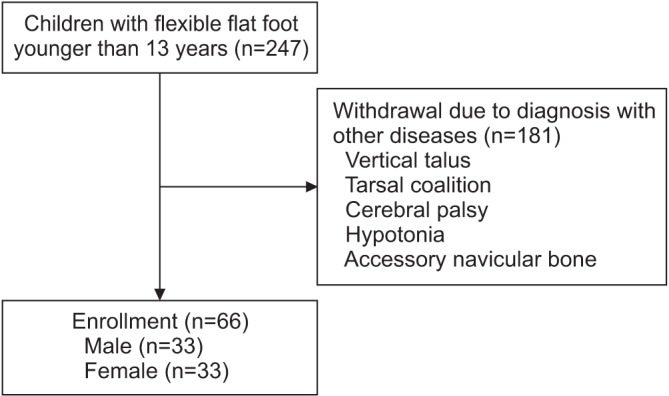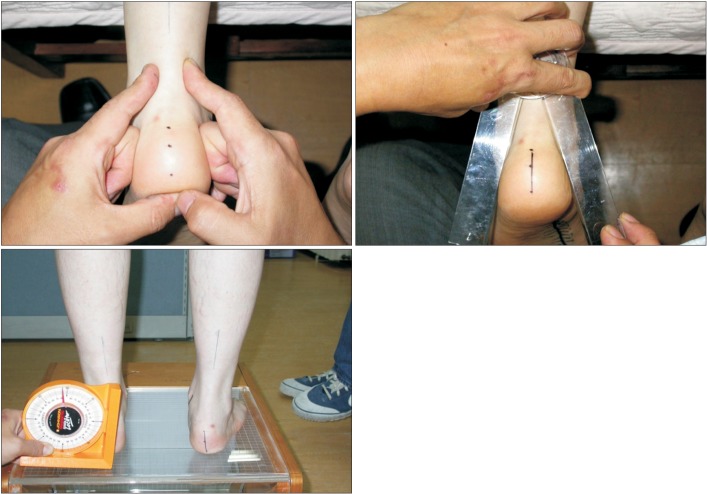INTRODUCTION
Flatfoot results in problems on the static alignment of ankle and foot, as well as to the dynamic functional abnormality of the lower extremities [
1]. Thus, proximal joints like the knee joints, hip joints, and the lower spine get affected due to the overloading of a medial longitudinal arch [
2]. Proper diagnosis and subsequent management for flexible flatfoot is therefore crucial for preventing these complications.
Despite a high prevalence of pediatric flatfoot, no general consensus exists on the diagnosis of flatfoot.
Clinically, flatfoot is diagnosed with the height of the medial longitudinal arch of the foot, evaluated by indirect or direct methods. An indirect method includes a footprint, and direct methods include biomechanical and radiographic parameters [
3].
In a pediatric foot clinic, the resting calcaneal stance position angle (RCSPA) is a common biomechanical parameter to diagnose flatfoot. Sobel et al. [
4] reported on the values of RCSPA of 212 people without flatfoot, aged from 5 to 36 years. The study concluded that variation among studies existed for the normal values of RCSPA, although generally the RCSPA has high degree of reliability, independent of age, height and weight.
Till date, there is no consensus on the radiological diagnosis of flatfoot. The calcaneal pitch angle (CPA), talometatarsal angle (TMA), and metatarsal angle (MA) are all considered to be helpful for diagnosing flatfoot in clinics [
5]. Nevertheless, variability among researchers has been observed in the radiologic parameters used in clinics, and hence there is no universal agreement on normal values of radiologic parameters mentioned above, according to age.
Applying corrective insoles for children with flexible flatfoot still remains debatable among researchers. Moreover, the natural history of flexible flatfoot and correction of flatfoot by insole has been debated in many previous studies [
26789101112131415].
The objective of this study was to identify the changes of biomechanical parameters after applying modified insole in children with flexible flatfoot, and to assess the differences of these parameters following insole fitting, according to the age-matched subdivided groups.
DISCUSSION
Despite an absence of the definition of flatfoot, flexible flatfoot is reported in most children under the age of 10 years, and in at least 20% of the adult population [
1819]. However, clinical or radiological diagnosis on flatfoot has not reached any agreement within the research world. Therefore, the exact prevalence of the disorder is unknown. An epidemiological study revealed that flatfoot is thought to persist in 3% of the adult population [
6].
Although radiographic investigations are not necessary for diagnosis, they can help in the assessment of decreased flexibility, uncharacterized pain, and surgical planning [
20]. Since no consensus on the diagnosis of flatfoot exists, radiographic evaluations are often used in foot clinics as a reference to determine the magnitude of flatfoot. In a previous study, Kim et al. [
21] evaluated the weight-bearing lateral views of the foot in 52 patients with flatfoot, and compared them to 60 control groups; they concluded that the TMA and MA could be used in clinical practice, as radiologic parameters of diagnosis in all age populations.
This study was conceived and undertaken since researches on the correlation of RCSPA, which is a common method for diagnosis of flatfoot in clinics and includes radiologic parameters, are very few. In our study, among the three lateral views of radiologic parameters, the TMA exhibited a significant correlation with RCSPA (p<0.05).
Although flatfoot is often asymptomatic, foot pain is a frequent complaint during clinical assessment, especially after intense workouts or walking for a long time.
Flatfoot has been associated with problems in the ankle and foot structures, and further overloading could be transferred to more proximal lower extremities [
22]. Researchers have found that patients who presented with a moderate to severe flatfoot tended to have anterior knee joint pain and intermittent low back pain, twice as much as controls [
723]. However, it is not yet possible to predict the exact risks of disability or pain evoked by common foot disorders like flatfoot. When associated with severe foot pain, flatfoot can be referred for surgical intervention, but this is rare [
6]. Although the diagnostic criteria vary among researchers, it is anticipated that the majority of flexible flatfeet are physiologic and resolve spontaneously with age, without further treatment.
Most flexible flatfeet are physiologic and asymptomatic, and thus require no treatment. However, clinically, the patients should be closely monitored for any possible symptoms or signs of progression [
8924]. Children with symptomatic flexible flatfoot have a long imposed controversy—what is pathologic, when to treat or observe, how to treat, and when to undergo surgery [
24].
Applying foot orthotics for children with flexible flatfoot is still debatable. Many researchers believe that flatfoot resolves spontaneously over time [
25]. Mosca et al. [
6] found that foot orthotics helped in correcting the soft tissue deformity, but there was no change in the skeletal structure. Kwon and Myerson [
26] reported that radiologic parameters did not improve in patients applying over-the-counter insole and foot orthotics, as compared to patients without any management. In general, it is believed that foot orthoses are not required in patients with asymptomatic flatfoot. Evidence also indicates that early application of orthotics prevents the development of symptomatic flatfoot [
27].
Conversely, some previous studies have provided scientific evidence of prescribing foot orthoses. Halabchi et al. [
5] proposed an algorithm for treating flexible flatfoot in children afflicted aged over 8 years, that needs to be treated despite lack of symptoms. Also, once imaging studies exclude any underlying structural abnormality which requires surgical intervention, active management like orthoses should be applied to patients with any symptoms related to flatfoot. Tang et al. [
10] reported that excessive valgus movement of the rearfoot decreased significantly after applying forefoot medial posting orthoses in 10 patients with symptomatic flexible flatfoot. Aboutorabi et al. [
11] enrolled 30 children with flatfoot, and divided them into groups with foot orthoses, regular shoe, and barefoot, to show the effectiveness of foot orthoses. Various gait parameters were used, such as step length and width, walking velocity, symmetry, and center of pressure (CoP) displacement, to observe the difference among subjects. The group applying functional foot orthoses realized improvement in all parameters, as compared to the control group. In a recent study, Banwell et al. [
12] asserted that not much evidence was found in the use of orthoses for flexible pes planus. However, some evidence indicated an improvement of physical function and energy cost during walking. In a previous study, substantial improvement was realized after applying customized foot orthoses to correct the RCSPA, with immediate improvement of the RCSPA [
131415]. Through the use of a dynamic stabilizing insole and customized foot orthoses to correct the RCSPA to the vertical position for flexible flatfoot patients, objective evidence in the improvement of foot prints and RCSPA was found [
20].
In this study, the RCSPA values of both the right and left decreased in all age groups after adjusting insoles. As shown in
Table 1, a more severe degree (in terms of the RCSPA) was found in the left foot compared to the right foot in all age groups of flatfoot children. The correction rate of the RCSPA was more significant in the left foot compared to the right foot. The findings of this study corresponded with a previous study [
16]. Zifchock et al. [
28] found that the height of the longitudinal arch was higher in dominant foot (mostly right foot) than in the non-dominant foot (mostly left foot). The dominant foot is believed to be suitable for more delicate movement. On the other hand, the non-dominant foot is more appropriate for weight-bearing function. Overloading of a medial longitudinal arch makes the foot more pronated, which can explain why the RCSPA of left feet is smaller than that of right feet in most of subjects with flexible flatfoot in the study. In this study, 60 subjects among the 66 enrolled, had a dominant foot on the right side, which correlated with the results mentioned above.
A decrease in the RCSPA and the TMA was relatively large as age increased to 7 years. Contrastingly, a drop in the RCSPA was lesser in children older than 7 years, compared to that of children younger than 7 years. The results correlated with the previous studies that the normal developmental process of longitudinal arch begins around the age of 6, and is completed before the age of 10 [
67891928]. However, this correction of the RCSPA and the TMA is still debatable, whether it is because of a natural history of flatfoot or because of the effectiveness of a corrective insole.
We divided our subjects by 5 age-matched groups in the study. We also assessed by dividing into 2 groups, based on the time of completion of normal longitudinal arch: preschool group from 1–6 years, and school age group from 7–12 years (
Table 2). This was done to differentiate the effectiveness of insoles in 1–6 years from the combined effects of normal developmental process and insole effect in 7–12 years. As seen in
Table 2, The RCSPA difference [(Final RCSPA – Initial RCSPA) / Initial RCSPA] was greater in the preschool group than that of the school age group. Although natural developmental process cannot be ruled out completely, comparing the RCSPA difference among subgroups according to the age, corrective insoles were considered to have additional effect for children with flexible flatfoot. According to Mosca [
6], after the age of 6, RCSPA is supposed to normalize until age of around 10 years. After the age of 10 years, RCPSA remains unchanged. Therefore, the group aged from 10–12 years is thought to be able to exclude normal physiological maturation of the arch [
67891928].
Our study has some limitations. First, although the RCSPA was found to be a reliable measurement when used by the same examiner (intra-tester reliability) [
4], some errors are found in the interpretation of the results and the process of drawing conclusions, since this study was conducted in a situation where no consensus exists. Second, a control group was not involved in the study, as this research was conducted retrospectively. Thus, further study involving a control group is necessary to make conclusions regarding the effectiveness of insoles. Third, since this study focused on the changes of RCSPA following insole fitting in children with flexible flatfoot, other factors that might possibly affect changes of RCSPA, such as duration of follow-up, severity of flexible flatfoot and associated ligament laxity, were overlooked. Fourth, radiographic evaluations were planned for the final visit to demonstrate the changes of radiologic parameters following insole fitting in children with flatfoot. However, the concern of parents regarding radiation hazard and follow-up loss, made a repetitive evaluation difficult. Fifth, this research is a retrospective study, thereby lacking a number of subjects, especially in age group between 7–9 years and between 10–12 years. Thus, an accurate comparison was difficult among all age groups. In addition, the follow-up period for the RCSPA and the lateral view of radiographs varied among the subjects. Consequently, more prospective studies are required in future, with larger samples, longer follow-ups and the use of control groups, to confirm the therapeutic effects of an insole for flexible flatfoot.
In conclusion, this paper demonstrated that corrective insoles had an additional beneficial effect for flexible flatfoot in children younger than 13 years. However, there might be a hidden effect of normal structural pedal alignment during growth, accompanied with bony maturation and developmental process. Controversy still exists whether the treatment of flexible flatfoot is necessary in the vast majority of cases, or simple observation and advice to parents is sufficient. Further research needs to employ a prospective study which includes control groups, to discover the effectiveness of insoles and correlate the changes with biomechanical parameters.






 PDF
PDF ePub
ePub Citation
Citation Print
Print









 XML Download
XML Download